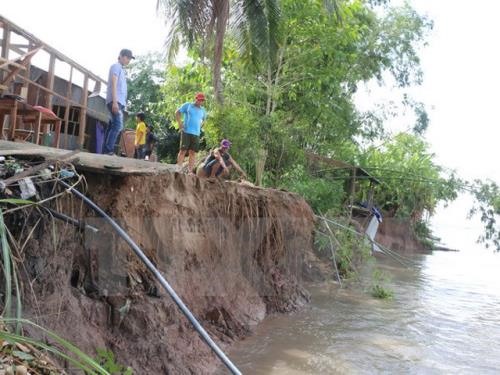 Environment
Environment

The sustainable development of the Cửu Long (Mekong) Delta faces many threats, especially the rising sea level, worsening land subsidence and declining sedimentation, Dr Lê Xuân Thuyên of the University of Natural Sciences has warned.
 |
| A severe landslide that occurred along a bank of the Tiền River in Thanh Bình District in the Mekong Delta province of Đồng Tháp last April. — VNA/VNS Photo Nguyễn Văn Trí |
HCM CITY — The sustainable development of the Cửu Long (Mekong) Delta faces many threats, especially the rising sea level, worsening land subsidence and declining sedimentation, Dr Lê Xuân Thuyên of the University of Natural Sciences has warned.
Speaking at a seminar last Thursday in HCM City titled "Challenges for sustainable development of the Mekong Delta," Thuyên said: "The delta is formed by sediments and fairly steady sea levels. Now the two elements are no longer present and so the delta is facing an uncertain future."
The delta used to receive an average of 160 million tonnes of sediment a year, enough to fully cover it to around 2mm depth thick, he said.
But by 2004 the sedimentation had decreased by a third and could decline further in future because of the construction of dams upstream, he said.
In addition, land is sinking at 10 times the rate sedimentation is forming new land, he said.
A published study showed that coastal areas and mangrove forests in the delta are sinking by around 3cm a year while other places are subsiding by over 1cm.
Human activities also affect the delta’s situation, such as the construction of dams which block sedimentation and thus cause erosion along the banks of rivers and streams.
The use of water upstream increases salinity levels as less fresh water flows back to meet seawater.
Dr Đào Ngọc Cảnh of Cần Thơ University said irrigation systems controlling floods and saline intrusions in the Long Xuyên Quadrangle and Đồng Tháp Mười (Plain of Reeds) regions increase the amount of land available for agriculture but cause the loss of water storage capacity.
Floods distribute silt and nutrients along the delta, and a cessation increases the risk of erosion in the delta, he said.
Consequently, the delta is shrinking at its mouth, he warned.
Seeking solutions
Thuyên said the biggest challenge is the lack of full understanding of the delta, which easily leads to wrong conclusions.
Experts said if sea levels rise by one to two metres in the 21st century, the extent of coastal submersion in developed countries would increase by several times compared to the likely submersion in case of a moderate rise.
Thuyên said the delta should have long-term solutions rather than short- or medium-term ones to resolve these problems.
"Solutions need to be researched and considered carefully.”
The delta has a coastline of nearly 1,000km and hundreds of kilometres of rivers and tributaries, and these require a large outlay for building sea dykes and embankments. — VNS




